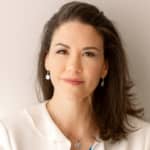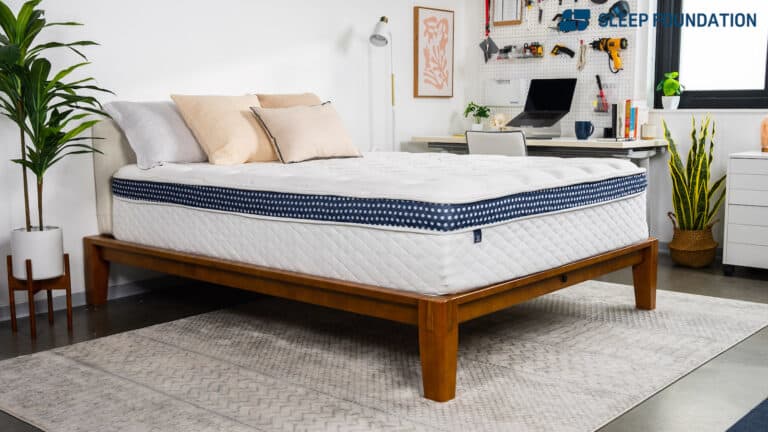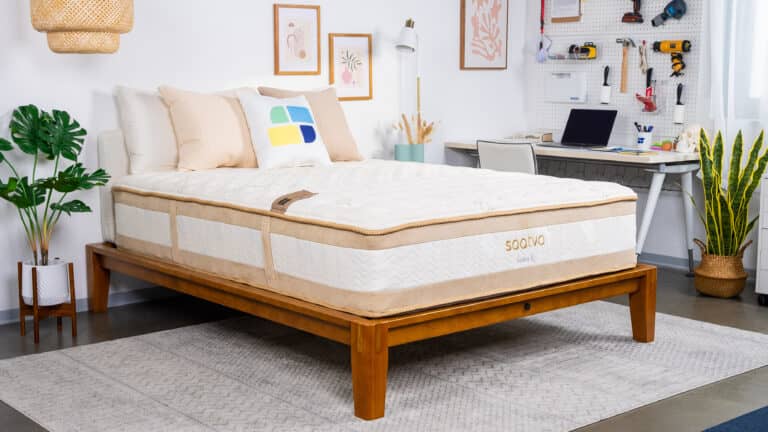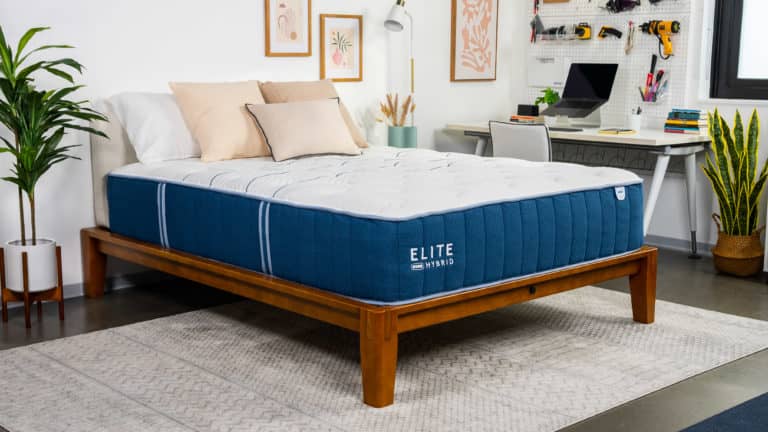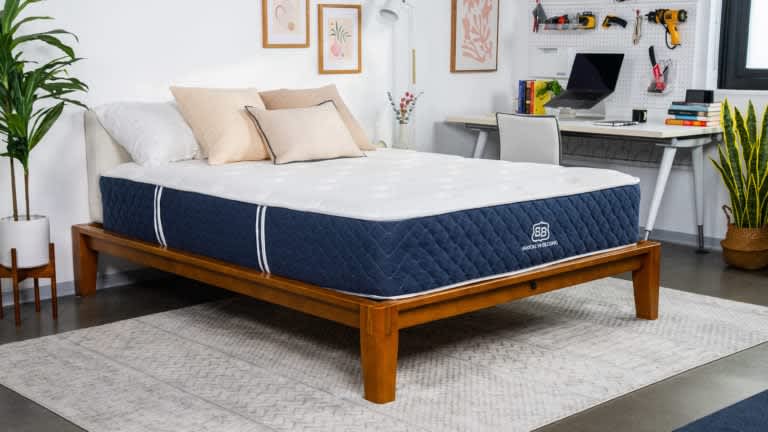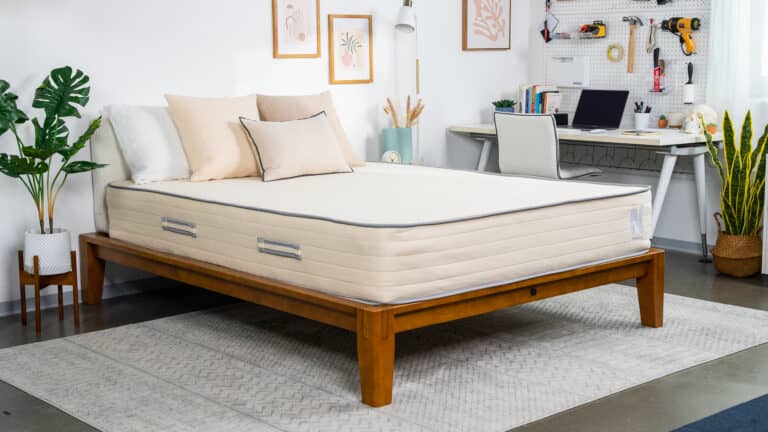When you buy through our links, we may earn a commission. Products or services may be offered by an affiliated entity. Learn more.
Roughly 2% to 3% of the U.S. population has scoliosis, a condition characterized by an unnatural curvature of the spine. Scoliosis can cause pressure and sore spots in areas along the spine, making it difficult to get a good night’s sleep. While a mattress can’t cure scoliosis, some beds can provide the right amount of support to improve spinal alignment and alleviate pressure where it’s needed. This can ensure people with scoliosis get the high-quality sleep they need.
Our Top Picks
-
Best Overall – Luxury Firm WinkBed
View Details
-
Best Value – Brooklyn Bedding CopperFlex Memory Foam
View Details
-
Most Comfortable – Leesa Sapira Chill Hybrid
View Details
-
Best for Back Pain – Saatva Rx
View Details
-
Best for Side Sleepers – Helix Midnight Luxe
View Details
-
Best for Hip Pain – Bear Elite Hybrid
View Details
-
Best for Spinal Alignment – Nolah Natural 11
View Details
-
Best Firm Mattress – Plank Firm Luxe
View Details
Swipe for more
Best Overall
Luxury Firm WinkBed
9.5 /10
Test Lab Score
Get $300 off all mattresses at Winkbeds
Get $300 off all mattresses at Winkbeds
The WinkBed comes in three firmness levels, but our testers found that the Luxury Firm model offers the optimal blend of spinal alignment and pressure relief. It’s responsive with exceptional edge support and enough cushioning to prevent pressure points from developing.
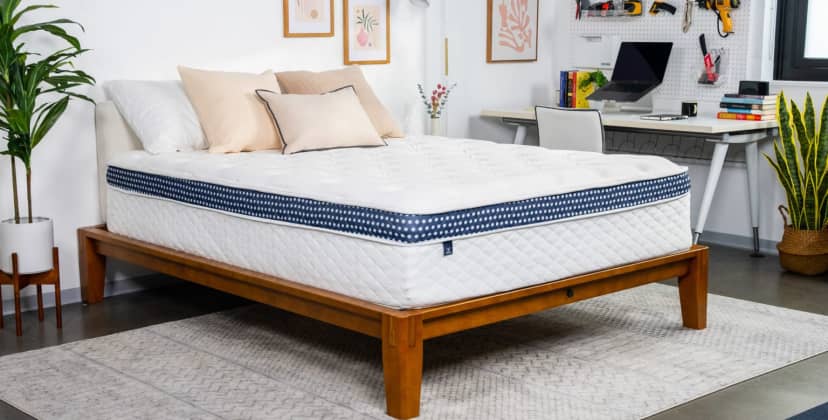
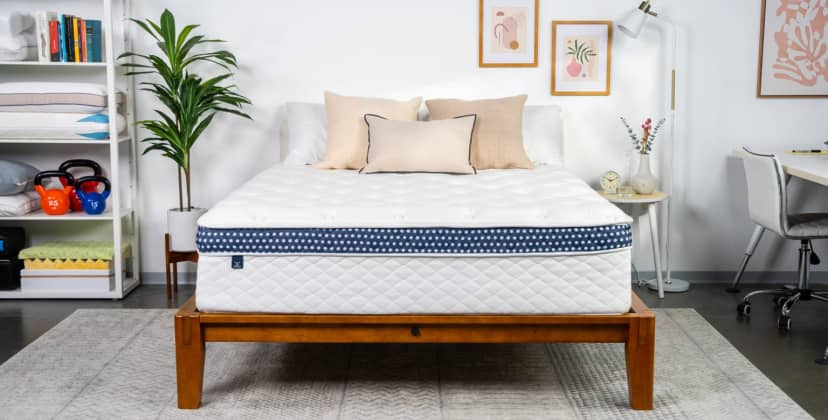
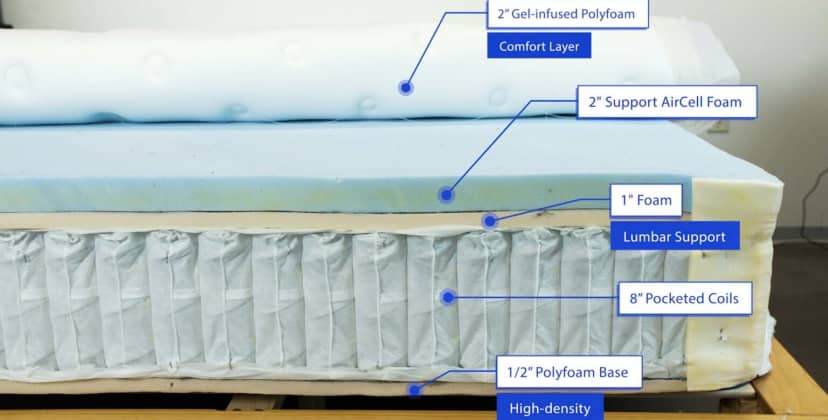
Credit: Sleep Foundation Test Lab
Price
$2,570
Mattress Type
Innerspring
Firmness Options
Medium Firm (6)
Trial Period
120 nights (30 night requirement)
At a Glance
- Who It’s Best For: Back and side sleepers.
- Feel: Balanced: cushions the body without compressing too deeply. Strong pushback that aligns the spine without causing discomfort beneath the hips and lower back.
- What It’s Made Of: Quilted, dual-layer polyfoam Euro-top with a gel infusion. Pocketed coil support core has five zones to support spinal alignment.
- What We Don’t Like: May feel motion transfer.
Scoring & Reviews
The following ratings show how suitable this mattress is for different sleeping positions and sleeper weights. These scores are determined by how well the mattress supports and relieves pressure for each sleeper type.
We performed a meta-analysis on 8573 validated customer reviews of the Winkbed. This is what people who bought the mattress had to say:- Quality of Materials: The mattress is frequently described as well-made, with durable materials that contribute to a good night’s sleep.
- Cooling Features: Some reviewers mention that the mattress does a good job of regulating temperature, providing a cooler sleep experience.
- Edge Support: While generally satisfied with the support, a few reviewers note that edge support could be better.
- Comfort and Support: Many reviewers praise the mattress for its comfort and support, often mentioning relief from back pain and improved sleep quality.
- Firmness Options: Customers appreciate the variety of firmness options available, finding the right balance for their personal preferences.
- Value for Money: Many users feel the mattress is worth the investment, offering good value for the quality and comfort provided.
- Made in the USA: Buyers are pleased that the mattresses are made in the USA, supporting domestic manufacturing.
Full Details
The Luxury Firm WinkBed delivers targeted spinal support for people with scoliosis, using a combination of foam comfort layers and zoned pocketed coils. A breathable cover, gel-infused comfort layer, and a coil support core also allow for a healthy amount of airflow to keep the mattress cool.
How It Performs
Thanks to its medium firm (6) feel, this mattress ranked highly among our testing team’s back and stomach sleepers, particularly those weighing up to 230 pounds.
Our side-sleeping testers between 130 and 230 pounds also enjoyed the balanced feel. This model boasts excellent edge support due to reinforced coils around the perimeter of the bed. Combination sleepers will appreciate the bed’s responsive surface, which facilitates movement and is an advantage for sex.
Construction Breakdown
A plush Euro-top cover provides some initial pressure relief. Gel-infused polyfoam is quilted into the pillow top for an extra luxurious feel. The gel in the cover is engineered to draw heat away from the body.
Underneath is a layer of specialized SupportCell polyfoam. This foam layer is denser to limit sinkage and evenly distribute weight, promoting a healthy sleep posture. The support core is comprised of pocketed coils. These support coils are zoned for targeted support, and they reinforce the perimeter of the mattress.
Trial, Shipping, and Warranty
WinkBeds offers free shipping to the contiguous U.S. and a 120-night sleep trial with a 30-night break-in period. The Luxury Firm WinkBed is also backed by a lifetime warranty that covers workmanship and manufacturing defects.
Best Value
Brooklyn Bedding CopperFlex Memory Foam
8.6 /10
Test Lab Score
30% off sitewide
30% off sitewide
The Brooklyn Bedding CopperFlex Memory Foam uses six individual foam layers to cushion your body and alleviate pain in your most sensitive areas. Zoned transitional foam and high-density base layers prevent you from sinking too deeply into the mattress, minimizing scoliosis-related discomfort in the process, but the surface is invitingly plush for a comfortable night’s sleep.

Credit: Sleep Foundation Test Lab
Price
$466
Mattress Type
Foam
Firmness Options
Medium Firm (6)
Trial Period
120 nights (30-night requirement)
At a Glance
- Who It’s Best For: Side sleepers who weigh at least 130 pounds and back sleepers up to 230 pounds, as well as couples and hot sleepers.
- Feel: Medium firm (6) foam mattress that feels fairly plush on the surface and contours to a noticeable extent. Offers pushback and has extra support for your midsection. Comfortable surface temperature, as well.
- What It’s Made Of: Adaptive polyfoam sewn to the bottom of the cover. Two memory foam layers and a zoned transitional foam layer with a support core of two high-density polyfoam layers. Cover is made of proprietary GlacioTex cooling fabric.
- What We Don’t Like: Some strong (but temporary) off-gassing odor after unboxing. Too soft for most stomach sleepers and not supportive enough for back sleepers over 230 pounds.
Scoring Breakdown
The following ratings show how suitable this mattress is for different sleeping positions and sleeper weights. These scores are determined by how well the mattress supports and relieves pressure for each sleeper type.
We performed a meta-analysis on 549 validated customer reviews of the Brooklyn Bedding CopperFlex Memory Foam. This is what people who bought the mattress had to say:- Pricing and Value: Many reviewers have highlighted that the mattress is affordable and offers great value for the price, making it an excellent choice for budget-conscious shoppers.
- Heat Regulation: Several users noted that the mattress does not retain much heat, which contributes to a cooler and more comfortable sleep, especially for those who tend to sleep hot.
- Edge Support: The mattress is reported to have good edge support, which is beneficial for those who use the edge of the bed frequently or sleep close to the sides.
- Odor and Off-Gassing: Some reviews mention that the mattress has minimal off-gassing odor upon unpacking, which is a common concern with new mattresses. The smell will dissipate in a few days.
- Hybrid Option: The availability of hybrid models is appreciated, particularly for those needing more support, such as individuals with larger frames.
- Customer Service: Positive remarks about customer service suggest that the company handles queries and issues effectively.
Full Details
A high-quality mattress that helps alleviate your scoliosis-related pain doesn’t need to break the bank. Case in point: the Brooklyn Bedding CopperFlex Memory Foam, a six-layer mattress with a plush, adaptive surface and a supportive base.
Zoned transitional foam delivers targeted pushback to your torso and hips, so these areas shouldn’t sink too much, while a copper fiber infusion reduces heat buildup to help you stay cool.
How It Performs
Most members of our testing team awarded favorable ratings to the CopperFlex Memory Foam, with the most enthusiastic feedback coming from our side sleepers who weigh 130 pounds or more and our back sleepers who weigh 230 pounds or less.
The mattress offers a nice balance of surface-level cushioning and underlying support, and the zoned transitional layer provides a good buffer to keep your body on an even plane.
The CopperFlex performed quite well during our motion isolation tests. Most of our team noticed little to no movement transferring when lying side by side on the mattress.
We also found the mattress sleeps fairly cool – you may notice some heat buildup, but not nearly as much as you’d find with most competing memory foam mattresses.
Construction Breakdown
The CopperFlex begins with a thin layer of adaptive polyfoam and two memory foam layers encased in a luxurious Euro-top cover. Copper fibers infused in the top memory foam layer are intended to dissipate heat away from the surface, as is the cooling GlacioTex cover.
The transitional polyfoam layer is divided into three zones, so it feels denser and more supportive beneath your midsection. Two high-density polyfoam layers make up the support core.
Trial, Shipping, and Warranty
The CopperFlex Memory Foam qualifies for free ground shipping within the contiguous U.S. and comes with a 120-night sleep trial. If you keep it, your purchase is covered under a lifetime warranty against manufacturing defects.
Most Comfortable
Leesa Sapira Chill Hybrid
9.0 /10
Test Lab Score
25% off sitewide
25% off sitewide
The Leesa Sapira Chill Hybrid offers ample cushioning for people who struggle with sleep due to scoliosis-related pain. Three firmness options make the mattress suitable for a wide range of side, back, and stomach sleepers.

Credit: Sleep Foundation Test Lab
Price
$1,698
Mattress Type
Hybrid
Firmness Options
Medium (5), Medium Firm (6), Firm (7)
Trial Period
120 nights (30-night requirement)
At a Glance
- Who It’s Best For: Side and back sleepers across most weight groups and stomach sleepers up to 230 pounds.
- Feel: Sold in medium (5), medium firm (6), and firm (7) designs.
- What It’s Made Of: A four-layer comfort system with gel-infused foam, memory foam, and adaptive polyfoam over zoned pocketed coils with perimeter reinforcement and high-density base foam.
- What We Don’t Like: The 14-inch profile requires a fitted sheet with deep pockets, and initial off-gassing odor can be overwhelming for the first few nights.
Scoring & Reviews
The following ratings show how suitable this mattress is for different sleeping positions and sleeper weights. These scores are determined by how well the mattress supports and relieves pressure for each sleeper type.
We performed a meta-analysis on 25 validated customer reviews of the Leesa Sapira Chill Hybrid. This is what people who bought the mattress had to say:- Suitability for Different Sleepers: Several reviews highlight that the mattress is suitable for side sleepers, stomach sleepers, and even for those who experience hip and shoulder pain.
- Temperature Regulation: Some reviews mention the mattress being cool and comfortable, while others complain about it sleeping hot, despite being the “Chill” version.
- Quality and Durability Concerns: A few reviewers express concerns about the mattress’s durability or mention receiving a damaged product.
- Overall Satisfaction: While many reviews are overwhelmingly positive, scoring 5 out of 5, there are a few lower scores where users mention issues like the mattress being too soft, too bouncy, or not meeting expectations in terms of firmness and comfort.
- Specific Needs: Some reviews from users with back pain or who have had long-term use of other mattresses indicate that this model significantly improved their sleep quality and comfort.
Full Details
Comfort is subjective – a mattress that meets all of your needs might be inadequate for someone else – but some mattresses come closer to being universally comfortable than others. Take the Leesa Sapira Chill, a foam-over-coil hybrid available in medium (5), medium firm (6), and firm (7) designs to accommodate a wide range of sleeper types. Thick comfort layers deliver plush cushioning, while the zoned support system helps ensure extra pushback for your torso and hips.
How It Performs
Our team tested all three of the Sapira Chill’s designs. We found that the medium model provides enough contouring for side and back sleepers under 130 pounds, who typically need a softer surface to rest comfortably. Side and back sleepers between 130 and 230 pounds will probably prefer the more supportive build of the medium firm (6), while those over 230 pounds should consider the robust firm (7) design. Stomach sleepers up to 230 pounds should receive enough reinforcement from the latter, as well.
Thanks to its thick foam layers, the Sapira Chill excelled during our motion isolation and pressure relief tests. The medium model earned the highest ratings in these categories, but all three were above average compared to other hybrids we’ve tested. Temperature control was another strength we noted, and this can be attributed to breathable open-cell foams in the comfort layers and steady airflow through the coil system.
Construction Breakdown
The Sapira Chill Hybrid contains more than 5 inches of foam cushioning, beginning with 2 inches of gel-infused polyfoam sewn to the cover. Additional layers of memory foam and adaptive polyfoam add to the surface’s invitingly plush feel, while transitional foam forms a gentle barrier between your body and the support core.
Pocketed coils and high-density base foam provide excellent stability for the mattress. The coils are zoned, meaning they feel more robust beneath your midsection – this helps ensure your torso and hips don’t sink too much. Reinforced perimeter coils also protect the edges from compression when you get in and out of bed.
Trial, Shipping, and Warranty
Leesa ships free of charge to customers in all 50 states and some Canadian locations. The Sapira Chill Hybrid’s sleep trial spans 120 nights in length. If you keep the mattress after the return period ends, your purchase is also covered under a lifetime manufacturer’s warranty.
Best for Back Pain
Saatva Rx
8.5 /10
Test Lab Score
$300 off orders of $1,000 or more
$300 off orders of $1,000 or more
The Saatva RX is designed with back pain in mind, which is clear from its performance and construction. It’s a medium soft (4) hybrid with a lumbar pad engineered to alleviate lower back pressure. It has a unique support system that blends pocketed coils, microcoils, and polyfoam to support the spine while providing optimal levels of cushioning.

Credit: Sleep Foundation Test Lab
Price
$2,801
Mattress Type
Hybrid
Firmness Options
Medium Soft (4)
Trial Period
365 Nights ($99 Return Fee)
At a Glance
- Who It’s Best For: Side and back sleepers.
- Feel: Medium soft (4) with a gentle cradling sensation that relieves pressure while supporting the spine. Surface stays a relatively neutral temperature.
- What It’s Made Of: A comfort system of polyfoam, memory foam, and microcoils. The support core has 8 inches of pocketed coils, topped with 2-inch polyfoam modules.
- What We Don’t Like: Above-average price tag.
Scoring & Reviews
The following ratings show how suitable this mattress is for different sleeping positions and sleeper weights. These scores are determined by how well the mattress supports and relieves pressure for each sleeper type.
We performed a meta-analysis on 40 validated customer reviews of the Saatva Rx. This is what people who bought the mattress had to say:- Comfort and Support: A significant number of reviewers mentioned the comfort and support provided by the Saatva Rx mattress, particularly for those with chronic pain or orthopedic issues. Users reported significant improvements in sleep quality and reductions in pain.
- Product Quality: Feedback on the quality of the Saatva Rx mattress was overwhelmingly positive. Reviewers felt that the mattress was well-made and worth the investment, often citing the materials and construction as superior to other brands.
- Temperature Regulation: Some reviewers appreciated the temperature regulation features of the mattress, noting that it stayed cooler than other mattresses they had used, which contributed to a better sleep experience.
- Issues with Firmness and Support: While most feedback was positive, a few reviewers noted issues with the firmness and support of the mattress, particularly concerning edge support and suitability for lighter individuals. These were minor compared to the overall positive feedback but were important for some buyers’ comfort.
- Return and Exchange Policy: Saatva’s return and exchange policy was frequently mentioned as a positive aspect, with customers feeling reassured by the ability to return or exchange the mattress if it did not meet their needs. This policy enhanced customer confidence in making a purchase.
Full Details
The Saatva Rx is a hybrid model with a unique coil-on-coil design specifically aimed at sleepers who experience chronic joint and back pain. Generous cushioning and responsive coils produce a balanced mattress that relieves pressure buildup without sacrificing too much support.
How It Performs
The Saatva Rx has a medium soft (4) feel that’s plusher than most hybrids we’ve tested. The foam layers offer excellent contouring, so our testers recommend this bed for anyone who needs deep cradling for painful pressure points.
Meanwhile, minicoils in the support core and pocketed coils in the base both ensure your body never sinks too far into the mattress. This helps promote even spinal alignment, which is crucial for people with scoliosis. We found the mattress was a good fit for side sleepers regardless of their body type, and back sleepers weighing less than 130 pounds.
One area where the Saatva Rx performed surprisingly well was ease of movement. Mattresses with plush surfaces typically inhibit mobility, but our testers moved with relative ease across the responsive surface. This is beneficial for sleepers with aches and pains related to scoliosis. The mattress also excelled in motion isolation, so you’ll experience fewer sleep disruptions when a partner shifts during the night.
Construction Breakdown
The Rx measures 15 inches thick, which is considered a high profile compared to other mattresses on the market. The organic cotton cover is quilted with foam to create a generously cushioned surface, while a thin memory foam pad underneath the lumbar region boosts support to the lower back. This is followed by a microcoil layer encased in high-density polyfoam.
The support core contains 8 inches of pocketed coils. Above the coils is a layer of Rx Foam Modules, which are polyfoam pieces that sit atop each individual coil. These foam pieces are 2 inches thick and are meant to reduce motion transfer. The Rx Foam is also infused with phase change material and graphite to promote cooling.
Trial, Shipping, and Warranty
Saatva offers free White Glove delivery to addresses in the contiguous U.S. This includes setup in the room of your choice and removal of your old mattress, if desired. You’ll receive a one-year sleep trial and a lifetime warranty.
Best for Side Sleepers
Helix Midnight Luxe
9.7 /10
Test Lab Score
25% off sitewide
25% off sitewide
The Helix Midnight Luxe lives up to its name, thanks to high-end materials and thoughtful construction details. This model is crafted with side sleepers in mind. It has zoned support with extra pushback beneath the hips and a memory foam comfort system that adapts to the body’s shape. Though it’s ideal for side sleepers, our team found this model to be quite well-rounded and comfortable for a range of sleepers.
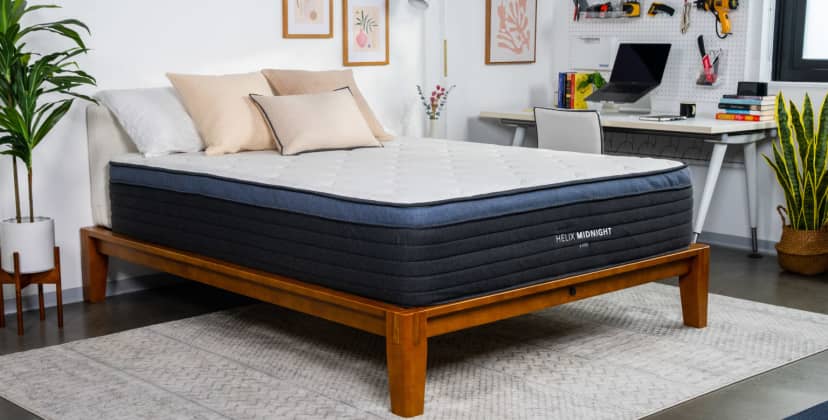
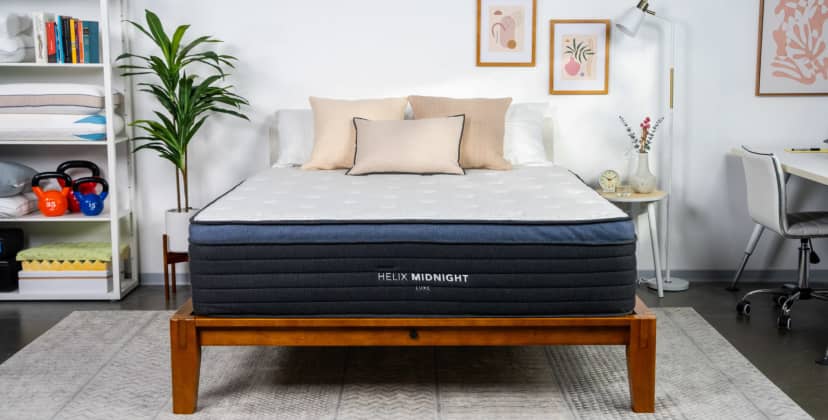
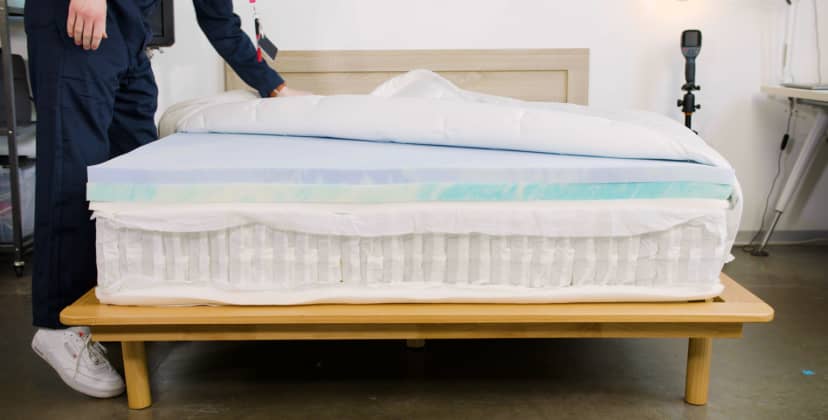
Credit: Sleep Foundation Test Lab
Price
$1,799
Mattress Type
Hybrid
Firmness Options
Medium Firm (6)
Trial Period
120 nights (30-night requirement)
At a Glance
- Who It’s Best For: Side sleepers, particularly those between 130 and 230 pounds, and back sleepers.
- Feel: Balanced: relieves pressure by adapting to the body’s shape and enough pushback to maintain an even sleep surface without major sinkage.
- What It’s Made Of: Three layers in the comfort system, two made from memory foam and one from polyfoam. The pocketed coil support core has several different support zones, as well as a reinforced perimeter. High-density polyfoam forms the base.
- What We Don’t Like: Not quite right for stomach sleepers under 130 pounds and over 230 pounds.
Scoring & Reviews
The following ratings show how suitable this mattress is for different sleeping positions and sleeper weights. These scores are determined by how well the mattress supports and relieves pressure for each sleeper type.
We performed a meta-analysis on 5876 validated customer reviews of the Helix Midnight Luxe. This is what people who bought the mattress had to say:- Comfort and Support: Many reviewers express that the mattress provides exceptional comfort and support, especially noting its ability to alleviate back, hip, and shoulder pain.
- Sleep Quality Improvement: The mattress is frequently described as transformative for those who previously struggled with sleep disturbances.
- Temperature Regulation: Positive remarks are made about the cooling properties of the mattress. Users find the cooling aspect effective, helping to maintain a comfortable sleeping temperature throughout the night.
- Customer Service: Experiences with customer service are predominantly positive, with buyers appreciating the responsive and helpful nature of the support team. Issues are resolved satisfactorily, contributing to a positive overall customer experience.
- Durability Concerns: A few reviewers express concerns about the mattress showing signs of wear or sagging prematurely. These concerns are not widespread but are significant enough to be noted by potential buyers.
- Mixed Reviews on Firmness: While many find the mattress perfectly balanced, there are mixed reviews regarding its firmness. Some users find it softer than expected given its firmness level. While the ‘medium firm’ rating is appropriate by our measurements, the bed does have a ‘cushy’ foam feel that makes for a fairly soft surface feel.
Full Details
The Midnight Luxe from Helix is a hybrid mattress that successfully balances pressure relief and spinal alignment, a combination that’s sought after by many people with back pain.
As a medium firm (6) on the firmness scale, this mattress is best suited to side and back sleepers, particularly those who weigh up to 230 pounds. Stomach sleepers and people who weigh above 230 pounds may find a firmer mattress more comfortable.
How It Performs
The Helix Midnight Luxe excels at isolating motion, thanks to its foam comfort layers. Instead of transferring your movement across the bed’s surface, the memory foam absorbs it. Sleepers who toss and turn and those with different sleep schedules from their partner often find this feature beneficial.
Hot sleepers may also appreciate the airflow from the coil support core and the breathable cover. Those who get pressure points while sleeping may find the foam comfort layers most appealing, as memory foam is engineered to closely contour and alleviate discomfort.
Construction Breakdown
The Midnight Luxe’s uppermost layer is a quilted pillow-top wrapped in Tencel. This layer adds a bit more cushioning and helps the mattress stay cool. The comfort system is designed with pressure relief in mind and features two layers of memory foam.
A transitional layer of polyfoam creates a buffer between the core and comfort layers. Zoned, pocketed coils form the core and offer targeted support. These coils are softer beneath your shoulders and firmer under your hips, which helps to keep your spine evenly aligned while you sleep. The Midnight Luxe’s base is made from a durable polyfoam.
Trial, Shipping, and Warranty
Helix ships for free to all 50 states. Canadian shoppers may incur additional fees. The Helix Luxe is backed with a lifetime limited warranty and your purchase includes a 100-night sleep trial.
Best for Hip Pain
Bear Elite Hybrid
8.5 /10
Test Lab Score
40% sitewide with code: SF40
40% sitewide with code: SF40
The Bear Elite Hybrid is an excellent choice for people with hip or joint pain. Its support system is separated into five distinct zones that provide strategic levels of pushback so that you get extra support where you need it and cushioning where you don’t. Together with the adaptive foam comfort system, this feature helps decrease impact and prevent pressure points from developing.
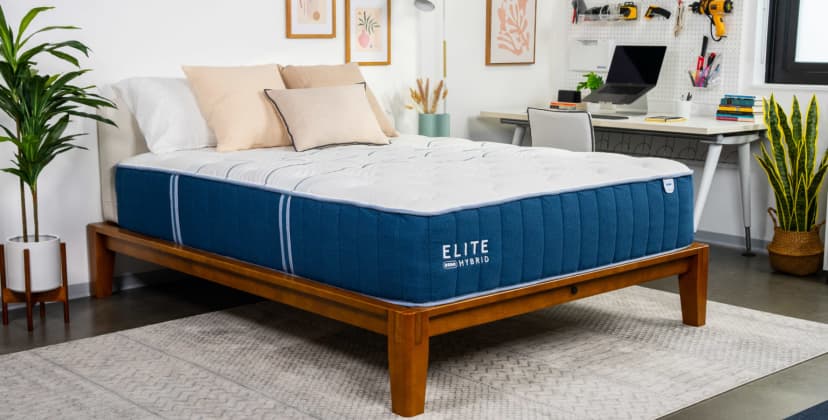
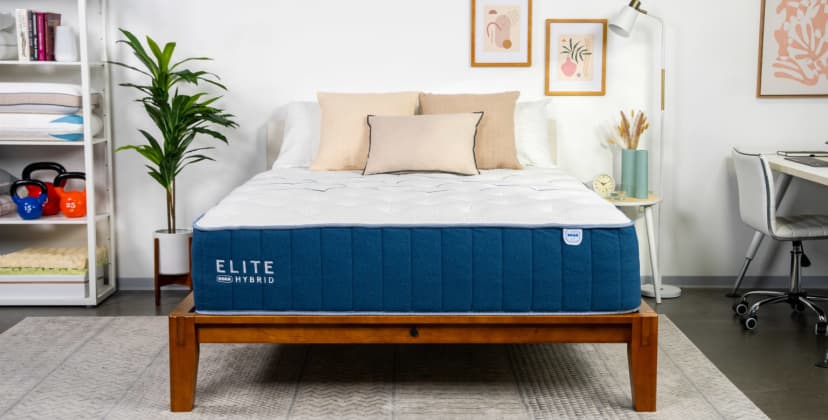
Credit: Sleep Foundation Test Lab
Price
$1,499
Mattress Type
Hybrid
Firmness Options
Medium (5), Medium Firm (6), Firm (8)
Trial Period
120 nights (30-night break-in period)
At a Glance
- Who It’s Best For: Back and side sleepers, depending on firmness level.
- Feel: Cushiony yet evenly supported, particularly beneath the hips. No excess sinking and feels quite cool.
- What It’s Made Of: Depends slightly on firmness levels, but there’s a comfort system with copper-infused memory foam and zoned polyfoam. The pocketed coil support core rests on top of a high-density polyfoam base. Cover is made of proprietary, quilted, cooling fabric.
- What We Don’t Like: May be tough for stomach sleepers, especially those over 230 pounds.
Scoring & Reviews
The following ratings show how suitable this mattress is for different sleeping positions and sleeper weights. These scores are determined by how well the mattress supports and relieves pressure for each sleeper type.
We performed a meta-analysis on 3703 validated customer reviews of the Bear Elite Hybrid. This is what people who bought the mattress had to say:- Comfort and Support: Many reviewers highlight the mattress’s balance of comfort and support, often mentioning relief from back pain and improved sleep quality.
- Firmness Options: Customers appreciate the various firmness options, with some opting for firmer versions after experiencing discomfort with medium firmness.
- Temperature Regulation: Several reviews note the mattress’s ability to stay cool, which enhances sleep quality, especially in hot weather.
- Size and Upgrade Options: Customers are pleased with the availability of different sizes and the option to upgrade, which provides flexibility for different needs and preferences.
- Quality of Additional Products: Positive remarks on the quality of accompanying products like pillows and sheets, which are often included as free additions.
- Motion Isolation: Many reviewers highlight the mattress’s excellent motion isolation, making it ideal for shared sleeping arrangements.
Full Details
If you wake up with sore muscles, stiff joints, and pressure buildup along the spine, we recommend the Bear Elite Hybrid. It features a deep comfort system with foam layers that contour closely to the body, resulting in even weight distribution and extra cushioning for your shoulders, lower back, and hips.
Another key component is the cover woven with phase change material (PCM) and Celliant, a material engineered to convert your body heat into infrared energy. This restorative process is intended to help you feel more refreshed in the morning.
How It Performs
We found the Bear Elite Hybrid to be very balanced in terms of contouring, responsiveness, and support. The variety of firmness options made the mattress popular among most of our testers.
Side and back sleepers up to 130 pounds were impressed with the medium feel, while most sleepers between 130 and 230 pounds were particularly impressed by the medium firm model. The firm option earned the highest marks from back and stomach sleepers over 230 pounds.
The mattress performed well during our temperature control tests. Our heat guns and thermal sensors show most testers experienced little to no heat buildup — we’ve attributed this to the PCM and Celliant’s cooling properties, a copper infusion in the top foam layer, and steady airflow through the coils.
The reinforced perimeter earned the mattress strong ratings for edge support, while the thick foam layers absorbed movement well.
Construction Breakdown
The Bear Elite Hybrid’s comfort system consists of two foam layers under a quilted cover. Adaptive memory foam gives the surface an initially plush feel, and a transitional polyfoam layer adds cushioning while pushing back against your weight. This layer is also zoned to deliver more support to heavier parts of the body. The mattress comes in three firmness levels — medium (5), medium firm (6), and firm (8).
The support core contains pocketed coils over high-density base foam, and the coils are zoned to enhance support to your lower back. Extra perimeter reinforcement reduces sinkage when you lie or sit along the edges, allowing you to get on and off the mattress with ease. The Bear Elite Hybrid is considered a high-profile model and may require deep-pocket sheets.
Trial, Shipping, and Warranty
Shipping is free in the contiguous U.S. Bear’s sleep trial lasts for 120 nights, and the mattress is backed by a standard lifetime warranty against structural defects.
Best for Pressure Relief
Brooklyn Bedding Signature Hybrid
8.4 /10
Test Lab Score
30% off sitewide
30% off sitewide
The Brooklyn Bedding Signature Hybrid’s three firmness options all offer similar levels of pressure relief that proved popular with the side and back sleepers on our testing team. It’s a well-made mattress with an affordable price-point, a sturdy support system, and a strong performance in our sleep lab.
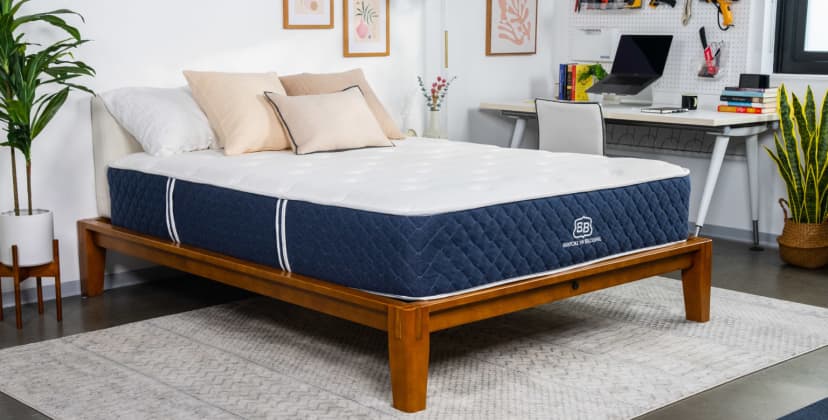
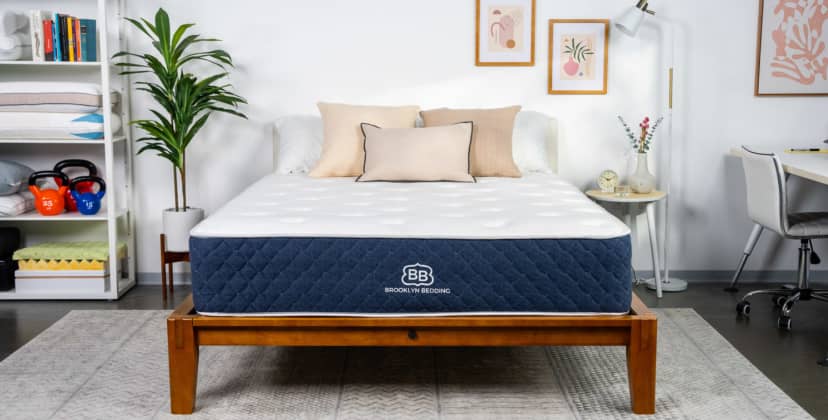
Credit: Sleep Foundation Test Lab
Price
$999
Mattress Type
Hybrid
Firmness Options
Medium Soft (4), Medium Firm (6), Firm (8)
Trial Period
120 nights (30-night requirement)
At a Glance
- Who It’s Best For: Those who want both pressure relief and support.
- Feel: Balanced: foam adapts to sleepers’ bodies but prevents excess sinking.
- What It’s Made Of: Topped by a gel-infused polyfoam layer made from proprietary foam, a transitional layer of polyfoam, pocketed coil support core, and a thick high-density polyfoam base.
- What We Don’t Like: Not great for stomach sleepers.
Scoring & Reviews
The following ratings show how suitable this mattress is for different sleeping positions and sleeper weights. These scores are determined by how well the mattress supports and relieves pressure for each sleeper type.
We performed a meta-analysis on 11,922 validated customer reviews of the Brooklyn Bedding Signature Hybrid. This is what people who bought the mattress had to say:- Comfort and support: Many reviewers mention that the mattress is very comfortable and provides good support for various sleeping positions.
- Improvement in sleep quality: Several users report a significant improvement in sleep quality, including better rest and reduced pain.
- Firmness options: People appreciate the availability of different firmness levels, and some discuss their experiences with medium, firm, or pillow-top options.
- RV suitability: A number of reviews specifically mention using the mattress in RVs, noting it as a substantial upgrade from typical RV mattresses.
- Initial odor/smell: Some reviewers note a mild odor upon unpacking, but it typically dissipates quickly.
- Edge support: The mattress is often noted for having good edge support, which is particularly valued by those who sit on the edge of the bed.
- Price and value: Many reviewers feel the mattress is well-priced for the quality and comfort it provides.
- Durability concerns: A few reviewers express concerns about how the mattress will hold up over time, although these comments are not widespread.
Full Details
The Brooklyn Bedding Signature Hybrid offers exceptional quality at an approachable price. Adaptive foam layers cushion and contour to your body without the deep hug of memory foam, while sturdy pocketed coils keep you on a flat, even plane. For added comfort, you can choose from medium soft (4), medium firm (6), and firm (8) designs based on your needs and preferences.
How It Performs
The medium soft design conforms very closely. As a result, this model earned excellent ratings from side sleepers on our testing team weighing up to 230 pounds, and back sleepers under 130 pounds.
Those seeking maximum support should opt for the firm model. Our back and stomach sleepers over 230 pounds were particularly impressed with this design. The medium firm model offers the most balance, earning solid ratings from our testers across most body types and sleep positions.
Despite its foam layers, the Signature Hybrid sleeps fairly cool and shouldn’t trap too much heat. If you’re an exceptionally hot sleeper, we recommend upgrading to the “Cloud Pillow Top” design.
The firmer two models received high marks for edge support and ease of movement, while the medium soft design fared best during our motion isolation and pressure relief tests.
Construction Breakdown
The Signature Hybrid’s top layer is composed of TitanFlex, a dense proprietary foam. Cooling gel infused into the foam helps the surface stay cool. A transitional polyfoam layer provides extra cushioning while creating a buffer between your body and the support core.
For an additional charge, you can upgrade your order to include a third foam layer sewn to the cover. This “Cloud Pillow Top” makes the mattress feel slightly plusher, and the foam is encased in phase change fabric for enhanced cooling.
Pocketed coils give the Signature Hybrid a strong, springy feel but shouldn’t generate too much motion transfer. At 10 inches thick, the mattress has a medium profile and won’t require a fitted sheet with deep pockets.
Trial, Shipping, and Warranty
Brooklyn Bedding offers free ground shipping throughout the contiguous U.S. Your order includes a 120-night sleep trial. If you choose to keep the mattress, your purchase is backed by a lifetime warranty covering structural and workmanship defects.
Best for Spinal Alignment
Nolah Natural 11
8.9 /10
Test Lab Score
35% off sitewide + extra $100 off with code: SF100
35% off sitewide + extra $100 off with code: SF100
People who want uncompromising spinal support should consider the Nolah Natural Mattress. It has zoned coils that provide an extra boost beneath the lower back and a latex comfort system that alleviates pressure build-up while remaining responsive. It’s also priced quite competitively for a hybrid that features organic materials.

Credit: Sleep Foundation Test Lab
Price
$1,364
Mattress Type
Latex Hybrid
Firmness Options
Medium Firm (6)
Trial Period
120 nights
At a Glance
- Who It’s Best For: Side and back sleepers, as stomach sleepers between 130 pounds and 230 pounds. Couples and hot sleepers, too.
- Feel: Medium firm (6). Feels quite buoyant and responsive. Sleep surface is even and doesn’t compress too deeply or sag at the edges.
- What It’s Made Of: A breathable organic cotton and wool cover atop two layers of Talalay latex that measure 3 inches in total. The pocketed coil support core is 8 inches thick and has three separate zones.
- What We Don’t Like: Responsive surface allows motion to transfer from one side to the other.
Scoring & Reviews
The following ratings show how suitable this mattress is for different sleeping positions and sleeper weights. These scores are determined by how well the mattress supports and relieves pressure for each sleeper type.
We performed a meta-analysis on 136 validated customer reviews of the Nolah Natural 11. This is what people who bought the mattress had to say:- Comfort and Support: Users frequently mention the Nolah Natural 11 mattress provides excellent comfort and support, helping alleviate back pain and improving sleep quality.
- Heat Retention Issues: Some reviewers have noted that despite claims of being temperature neutral, the mattress can retain heat, which has been a disappointment for those seeking a cooler sleep experience.
- Motion Isolation: The mattress is praised for its ability to isolate motion, allowing individuals to move without disturbing their partner, making it suitable for couples.
- Initial Off-Gassing: A few users reported a noticeable smell upon unpacking the mattress, although it typically dissipates after a few days.
- Firmness: Some customers have expressed concerns that the mattress is softer than advertised, particularly those who were expecting a firmer sleeping surface.
- Organic and Non-Toxic Materials: The mattress is highly rated for its use of organic, natural materials, which appeals to eco-conscious consumers and those sensitive to chemicals.
Full Details
The Nolah Natural 11 is a hybrid model with latex layers that gently conform to your body without sinking excessively beneath your weight. The light cushioning paired with a sturdy coil support core offers optimal spinal alignment, which is crucial for anyone with scoliosis.
How It Performs
The bed has a medium firm (6) feel that strikes an even balance between cushioning and support. During tests, the bed was most popular among our side sleepers weighing over 130 pounds and back sleepers up to 230 pounds. Stomach sleepers under 130 pounds also found the bed comfortable, though those over 130 pounds may need a more supportive model.
Latex, wool, and cotton are all naturally breathable materials, so it’s no surprise the Nolah Natural 11 excelled during our temperature control tests. Air also flows freely through the coil layer and the perforations in the latex, which helps ventilate the bed.
Our testers found the responsive surface very easy to move around on, making it suitable for sleepers who don’t enjoy beds that inhibit movement.
Construction Breakdown
The mattress begins with a breathable cotton cover and a thin layer of organic wool that wicks away moisture while serving as a fire barrier. Beneath is a layer of perforated latex that conforms to your body but also maintains a responsive feel, followed by a thinner latex layer with firmer support.
The pocketed coils are zoned to provide more push-back around the midsection, which helps prevent aches and pains in your shoulders and lower back. The cotton and wool carry GOTS certification to ensure organic sourcing.
Trial, Shipping, and Warranty
Nolah offers free shipping to the contiguous U.S. The sleep trial lasts 120 nights, but you can cut your up-front cost by as much as $150 by forgoing the trial period. The mattress is backed by a lifetime warranty against structural defects.
Best Firm Mattress
Plank Firm Luxe
8.2 /10
Test Lab Score
30% off sitewide
30% off sitewide
Some people just like a firm mattress, and the Plank Firm Luxe is designed with those people in mind. This model has a flippable design with two sleep surfaces – one that’s firm (7) and one that’s extra firm (9). It’s ideal for those who want an extremely even sleep surface that doesn’t compress under their weight, as well as people seeking high quality at a budget-friendly price-point.

Credit: Sleep Foundation Test Lab
Price
$1,149
Mattress Type
Hybrid
Firmness Options
Firm (7), Extra Firm (9)
Trial Period
120 nights (30-night requirement)
At a Glance
- Who It’s Best For: Those who like a firm or extra-firm bed. Sleepers over 130 pounds, especially those over 230 pounds.
- Feel: Even surface with subtle cushioning that can help prevent pressure points (firm side). The extra-firm side feels sturdy and responsive.
- What It’s Made Of: Firm side has a foam comfort system separated into two distinct layers, while the extra firm side has just one. The two surfaces share a 6-inch pocketed coil support core.
- What We Don’t Like: Very little pressure relief and doesn’t isolate motion very well.
Scoring & Reviews
The following ratings show how suitable this mattress is for different sleeping positions and sleeper weights. These scores are determined by how well the mattress supports and relieves pressure for each sleeper type.
We performed a meta-analysis on 1748 validated customer reviews of the Plank Firm Luxe. This is what people who bought the mattress had to say:- Comfort and firmness: Many reviewers discuss the comfort level of the mattress, often highlighting its firm feel. While all of those bought the mattress for its firmness, a few people still found the bed too firm.
- Cooling features: Several reviewers mention the cooling features of the mattress, specifically the Glaciotex Cooling Cover, which is appreciated for providing a cooler sleep experience.
- Pain relief: A recurring theme is the relief from back and joint pain, with many users noting improvements in their sleep quality and reduction in pain. Many users report improved spinal alignment, especially those who prefer firmer mattresses.
- Dual firmness options: The mattress’s ability to be flipped for different firmness levels (firm and extra firm) is frequently mentioned and appreciated by those who have different firmness preferences.
- Edge support: A lot of reviewers mention the strong edge support of the Plank Firm Luxe.
- Off-gassing: A few reviewers note the presence of off-gassing when the mattress is new, but it typically dissipates after a few days.
- Customer service: Experiences with customer service are generally positive, with reviewers appreciating the responsive and helpful support team. The 120-night trial period and responsive customer service are frequently noted as key advantages.
Full Details
Sleepers who want a mattress with uncompromising support should consider the Plank Luxe Hybrid. Much like the all-foam version of the Plank, this model is flippable with dual firmness levels of firm (7) and extra firm (9).
However, this mattress has a pocketed coil support core rather than foam, giving it enhanced responsiveness and temperature control. The Plank Luxe Hybrid also has an affordable price-point when compared to other premium hybrid mattresses.
How It Performs
This mattress is best suited to sleepers who prefer rigorous support and don’t require pressure relief. Back and stomach sleepers are likely to experience the best spinal alignment, with sleepers who weigh more than 130 pounds finding this mattress most comfortable.
Hot sleepers can also increase the bed’s already above-average temperature control by opting to add on a top cooling panel made from phase change material (PCM) fabric.
Construction Breakdown
Both sleep surfaces share the same pocketed coil support core. Individually encased coils move independently of one another to cut down on motion transfer.
Each side includes high-density polyfoam that increases support and provides very subtle contouring. The firmer surface has less quilting to ensure it feels truly extra firm. The other side uses an additional layer of proprietary TitanFlex polyfoam and more quilting to soften its surface and bring it down to a traditional firm feel.
Trial, Shipping, and Warranty
The Plank Luxe Hybrid ships free to the contiguous U.S. Each purchase includes a 120-night sleep trial, as well as a lifetime warranty.
- Spinal Support: The best mattresses for scoliosis provide the right amount of support to promote even alignment without feeling too stiff or rigid.
- Plush, Adaptive Surface: Mattresses with soft foam or latex layers beneath the surface deliver deep cushioning and cradling for people with scoliosis.
- Sturdy Perimeter: A mattress with strong edge support ensures you can lie in any position and take up as much of the bed as you need to sleep comfortably.
How We Evaluated & Reviewed
Meta Analysis: Of the 2,000+ mattresses in our product database, we narrowed down the list to models that earned favorable ratings for pain and pressure relief during our initial hands-on tests. From there, we chose 50 of the top candidates for best mattress for scoliosis.
Hands-On Testing: Our team evaluated ran all 50 of our mattress selections through a fresh round of tests. In addition to pressure relief, we tested each mattress for other performance metrics like motion isolation, temperature control, and edge support.
Field Testing: Next, we further narrowed down our list to 25 models. Each one went home with a member of our testing team, who slept on the mattress for roughly two weeks to see how it perform in a real-world sleep setting.
User Reviews: Our team pulled data from nearly 35,000 reviews from verified mattress owners to make sure our findings are consistent with the customers’ experiences.
The Best Deals of the Week
-
Save $199
—
Brooklyn Bedding CopperFlex Memory Foam
$466 (List Price $665) -
Save $600
—
Helix Midnight Luxe
$1,799 (List Price $2,399) -
Save $2,436
—
Nectar Adjustable Bundle
$1,398 (List Price $3,834) -
Save $771
—
WinkBed
$1,799 (List Price $2,570) -
Save $1,020
—
DreamCloud Classic Hybrid
$699 (List Price $1,719)
Best Overall
WinkBed
9.4 /10
Test Lab Score
30% off all WinkBeds mattresses
Shop at WinkBedsZoned support and adaptive foam provide even, pressure-free spinal support.
See More Details
Best Value
Brooklyn Bedding CopperFlex Memory Foam
8.6 /10
Test Lab Score
30% off sitewide
Shop at Brooklyn BeddingAn all-foam mattress that relieves pressure without breaking the bank.
See More Details

Credit: Sleep Foundation Test Lab
Most Comfortable
Leesa Sapira Chill Hybrid
9.0 /10
Test Lab Score
25% off sitewide
Shop at LeesaResponsive coils and a pressure-relieving comfort system offer targeted spinal and midsection support.
See More Details
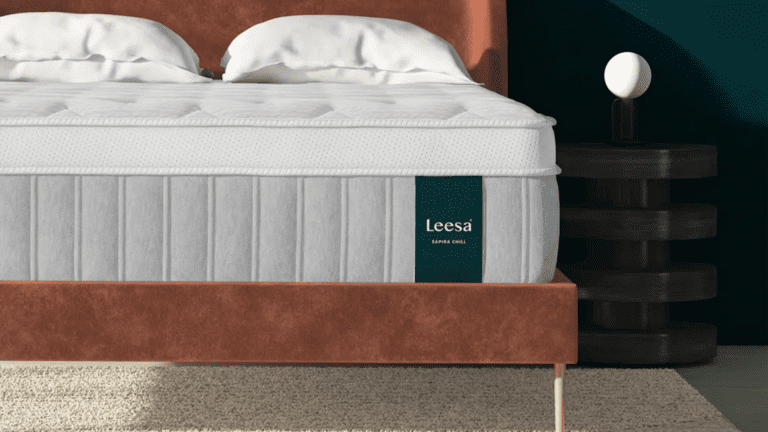
Best for Back Pain
Saatva Rx
8.5 /10
Test Lab Score
$300 off orders of $1,000 or more
Shop at SaatvaThoughtful and innovative details make the Saatva RX an excellent model for alleviating pain.
See More Details
Best for Side Sleepers
Helix Midnight Luxe
9.7 /10
Test Lab Score
25% off sitewide
Shop at HelixZoned support and pressure-relieving memory foam keep side sleepers comfortable and pain free.
See More Details
Best for Hip Pain
Bear Elite Hybrid
8.5 /10
Test Lab Score
40% sitewide with code: SF40
Shop at BearAdaptive foam and pocketed coils cushion hips and evenly distribute weight to prevent pain.
See More Details
Best for Pressure Relief
Brooklyn Bedding Signature Hybrid
8.4 /10
Test Lab Score
30% off sitewide
Shop at Brooklyn BeddingAdaptive foam and a robust coil system provide balanced pressure relief.
See More Details
Best for Spinal Alignment
Nolah Natural 11
8.9 /10
Test Lab Score
35% off sitewide + extra $100 off with code: SF100
Shop at NolahZoned pocketed coils and responsive latex keep sleepers’ spines supported and aligned.
See More Details
Best Firm Mattress
Plank Firm Luxe
8.2 /10
Test Lab Score
30% off sitewide
Shop at PlankA flippable hybrid mattress designed for people seeking to maintain alignment with the firmest option available.
See More Details

Credit: Sleep Foundation Test Lab
Compare the Best Mattresses for Scoliosis
Select up to 3 products to compare
|
Rating
|
Product |
Price |
|
|---|---|---|---|
|
/10 |
$2,570 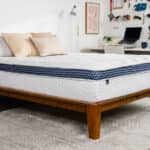
|
||
|
/10 |
$466 
|
||
|
/10 |
$1,698 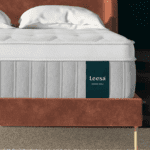
|
||
|
/10 |
$2,801 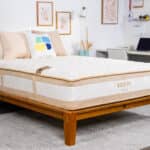
|
||
|
/10 |
$1,799 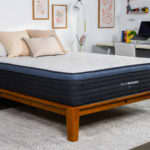
|
||
|
/10 |
$1,499 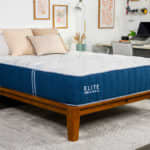
|
||
|
/10 |
$999 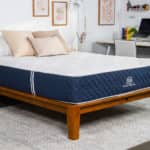
|
||
|
/10 |
$1,364 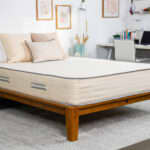
|
||
|
/10 |
$2,199 
|
||
|
/10 |
$1,149 
|
Compare Mattresses
Go back to select different products
Price
$2,570
$466
$1,698
$2,801
$1,799
$1,499
$999
$1,364
$2,199
$1,149
Mattress Type
Innerspring
Foam
Hybrid
Hybrid
Hybrid
Hybrid
Hybrid
Latex Hybrid
Hybrid
Hybrid
Firmness Options
Medium Firm (6)
Medium Firm (6)
Medium (5), Medium Firm (6), Firm (7)
Medium Soft (4)
Medium Firm (6)
Medium (5), Medium Firm (6), Firm (8)
Medium Soft (4), Medium Firm (6), Firm (8)
Medium Firm (6)
Medium Soft (4), Medium Firm (6), Firm (7)
Firm (7), Extra Firm (9)
Customer Rating
9.6/10
0.0/10
8.0/10
9.8/10
9.0/10
9.4/10
9.4/10
9.8/10
0.0/10
9.4/10
Side Sleepers (Under 130 lbs.)
9.5/10
7.0/10
9.0/10
9.0/10
9.5/10
8.5/10
8.5/10
8.0/10
8.5/10
5.5/10
Side Sleepers (130-230 lbs.)
10.0/10
9.0/10
9.5/10
7.5/10
10.0/10
9.0/10
9.0/10
8.5/10
9.0/10
6.5/10
Side Sleepers (Above 230 lbs.)
9.5/10
7.5/10
9.0/10
6.5/10
9.5/10
8.5/10
8.5/10
8.0/10
8.5/10
8.0/10
Back Sleepers (Under 130 lbs.)
8.5/10
8.0/10
8.0/10
7.5/10
8.5/10
7.5/10
7.5/10
9.0/10
7.5/10
7.0/10
Back Sleepers (130-230 lbs.)
8.0/10
7.0/10
7.5/10
7.0/10
8.0/10
7.0/10
7.0/10
8.5/10
7.0/10
7.5/10
Back Sleepers (Above 230 lbs.)
8.0/10
7.0/10
7.5/10
7.0/10
8.0/10
7.0/10
7.0/10
8.5/10
7.0/10
7.5/10
Stomach Sleepers (Under 130 lbs.)
8.5/10
8.0/10
8.0/10
7.5/10
8.5/10
7.5/10
7.5/10
8.5/10
7.5/10
8.0/10
Stomach Sleepers (130-230 lbs.)
7.5/10
6.0/10
7.0/10
7.0/10
7.5/10
6.5/10
6.5/10
7.5/10
6.5/10
8.5/10
Stomach Sleepers (Above 230 lbs.)
6.5/10
5.5/10
6.0/10
6.5/10
6.5/10
5.5/10
5.5/10
6.5/10
5.5/10
8.5/10
Motion Isolation
6.5/10
8.5/10
7.5/10
8.0/10
8.5/10
7.0/10
6.5/10
6.5/10
7.5/10
6.0/10
Edge Support
9.5/10
7.0/10
7.0/10
7.0/10
9.5/10
7.5/10
7.5/10
7.0/10
8.5/10
8.0/10
Temperature Control
9.0/10
7.0/10
7.5/10
8.0/10
8.0/10
7.0/10
7.5/10
8.5/10
7.0/10
8.0/10
Ease of Movement
7.5/10
6.5/10
8.0/10
7.0/10
7.5/10
6.5/10
6.5/10
8.0/10
6.5/10
8.0/10
Off-gassing
9.5/10
6.0/10
7.5/10
8.0/10
8.0/10
7.0/10
7.0/10
8.5/10
7.0/10
7.0/10
Pressure Relief
8.0/10
9.0/10
8.5/10
8.0/10
9.5/10
8.0/10
7.0/10
7.5/10
8.5/10
6.0/10
Product Review
Watch Video: We Tested the Best Mattresses for Scoliosis – Here Are Our Favorites
Watch the video below to learn more about our lab’s top mattress picks for people with scoliosis.
What Is Scoliosis and How Does It Affect Sleep?
Scoliosis is a condition where the spine curves abnormally, sometimes forming a visible “S” or “C” shape when viewed from the back. “It usually develops in childhood or adolescence, though adult-onset scoliosis is also possible,” says Dr. Audrey Wells, MD. “The exact cause is often unknown, but it can be related to genetic factors, birth defects, or other conditions like cerebral palsy or muscular dystrophy.”
According to Dr. Wells, symptoms of scoliosis vary depending on the severity of the curve. Common signs include uneven shoulders, one hip appearing higher than the other, or intermittent pain related to muscular compensation for altered posture against gravity. As the condition progresses, it can lead to chronic pain, muscle fatigue, and in more severe cases, breathing difficulties.
“The discomfort associated with scoliosis can interfere with sleep,” notes Dr. Wells, “as individuals may struggle to find a comfortable position. For some, lying flat on their back or side may exacerbate pain, while others might experience muscle stiffness or spasms during the night. Proper sleep posture, the use of supportive mattresses, and sometimes medical interventions are key in managing the impact of scoliosis on sleep quality.”
What Is the Best Sleeping Position for Scoliosis?
Back sleeping is typically considered the best sleeping position for scoliosis, as it keeps the spine in the most neutral position. You’ll probably also find back sleeping more practical if you wear a brace.
Stomach sleeping twists the head to one side, which may exacerbate back and neck pain. Similarly, side sleeping can put sideways pressure on the spine, and it may lead to breathing trouble for people with certain types of scoliosis. However, the best sleeping position can vary from person to person depending on their unique body and situation.
What Is the Best Mattress Type for Scoliosis?
The best mattress type for scoliosis depends on several factors, including your body type, sleeping style, individual symptoms, and whether or not you sleep with a brace. Among the broad mattress categories, each type offers distinct benefits and drawbacks.
Hybrid
Hybrid mattresses include a coil support core beneath significant comfort layers, which are often made of memory foam, latex, or similarly pressure-reducing materials. Innerspring mattresses are similar and also contain a coil support core but have little to no comfort layers.
Most hybrids are made with pocketed coils, which move independently of one another to evenly distribute body weight. As a result, hybrids typically offer above-average spinal support. Also, contouring materials in the comfort layers can help reduce pressure points, making hybrids ideal for many people with scoliosis.
Foam
Foam mattresses contain a high-density polyfoam support core beneath comfort layers that are most often made of polyfoam or memory foam.
The primary advantage of foam mattresses is their above-average pressure relief. Memory foam, in particular, molds to the shape of your body to prevent pressure buildup. While the polyfoam support core isn’t quite as supportive as innerspring coils, foam mattresses can still be a solid option for people with scoliosis who weigh less than 230 pounds.
Latex
Latex is a good option for people who want pressure relief, without feeling like they are being “hugged” by the bed. Synthetic latex offers similar properties but may not perform on par with natural latex. It’s a durable, responsive material, so it offers great support and is easy to move around on if you need to switch positions.
Airbed
The support core of an airbed mattress is formed by an air chamber that can be inflated for a firmer feel and more support, or deflated for a softer feel. Most airbeds also include several inches of comfort layers for additional pressure relief.
What Should Someone With Scoliosis Look for in a Mattress?
Certain factors are particularly important in a mattress if you have scoliosis. These mostly center on the mattress’ ability to provide pressure relief and spinal support.
Sleeping Position and Firmness
The right mattress firmness level for each sleeper largely depends on your body weight and usual sleeping position. Side sleepers and those under 130 pounds typically prefer softer mattresses to relieve pressure points. Stomach sleepers and people over 230 pounds tend toward firmer mattresses, which prevent them from sinking too far into the bed.
The right firmness for someone with scoliosis can vary depending on their individual profile. Many experts agree that medium firm is a good starting point, as this firmness provides sufficient support and decent pressure relief for most sleepers.
A mattress that’s too soft may fail to support the spine, which is an important consideration for someone with scoliosis. However, a mattress that’s too firm may put pressure on already-painful areas like the hips or shoulders.
Pressure Relief
Pressure relief is one of the most important attributes in a mattress if you have scoliosis, because scoliosis can cause pain points that may be exacerbated where your body puts weight on the mattress. Softer mattresses tend to offer better pressure relief than firmer mattresses.
“A mattress with a thick comfort layer can make a significant difference by cushioning pressure points,” says Dr. Wells. “Balanced with internal support features, the combination helps alleviate discomfort and pain in sensitive areas.”
Contouring
Materials like memory foam excel at contouring, or shaping themselves to fit the curves of your body. Contouring is closely related to pressure relief, as the more a material contours, the less chance there is of pressure forming where it contacts your body or brace. That said, some people may find it restrictive when a mattress contours too closely.
Responsiveness
Responsiveness is a material’s ability to quickly regain its original shape. The more responsive a mattress, the easier it is to change sleeping positions. If scoliosis limits your movement, you may value a more responsive mattress.
Edge Support
A mattress with strong edge support holds up well when weight is placed along the perimeter, preventing feelings of roll-off when you sleep near the edge of the bed. Strong edge support also provides a sturdy place to sit or lean on when getting in and out of bed.
Durability
All mattresses break down over time, eventually sagging and developing permanent body indentations. Once a mattress is no longer able to contour properly or support the spine on an even plane, it may start to aggravate back pain or other scoliosis-related symptoms. Choosing a mattress made with durable materials can help you get a longer lifespan out of your mattress.
Delivery and Setup
Mattresses sold online are usually compressed, rolled up, and placed in a box for shipping. To set up the mattress when it arrives at your house, you need to open the box, remove the plastic, lay the compressed mattress out on the bed frame, and let it expand.
Mattresses can be heavy and difficult to maneuver, especially for someone with back pain. If you anticipate trouble setting up the mattress, look for a company that offers White Glove delivery. With this option, often charged at a nominal fee, the delivery people set up the mattress for you and remove the packing materials.
Sleep Trial and Warranty
A sleep trial is a period during which a mattress company allows buyers to sleep on the mattress in their own home and return the mattress for a refund if they aren’t satisfied. Sleep trials typically last between 30 and 365 nights.
Because many mattresses soften over time, a sleep trial gives a more accurate impression of a mattress as opposed to simply lying on it in a store. If you have scoliosis, the trial allows you to better test the mattress’ pressure relief and spinal support.
Mattresses also typically come with a warranty of at least several years. During the warranty period, if the mattress displays any manufacturing flaws, you can request that the company replace or repair the mattress per the warranty conditions.
Tips for Sleeping More Comfortably With Scoliosis
While scoliosis has an undeniable effect on sleep quality for many people, there are steps you can take to sleep more comfortably if you have the condition.
Talk to Your Doctor
Because scoliosis varies from person to person, your doctor is the best person to recommend a mattress and sleeping position for your symptoms.
It’s important to seek help from a medical professional if you have symptoms of scoliosis. When symptoms are present, Dr. Wells notes that determining the presence and the severity of scoliosis begins with x-rays of the spine. If left untreated, some people with scoliosis progress to having more serious long-term health complications, including chronic pain, reduced mobility, and in severe cases, respiratory or cardiovascular issues.
Use Pillows Strategically
You can use pillows to support different body parts, depending on your sleeping position and the type of scoliosis you have. Examples of supportive pillow placement for scoliosis include:
- Under the knees: Back sleepers may experience pressure buildup in the lumbar area. Placing a thin pillow beneath the knees can take strain off the lower back.
- Between the knees: When sleeping on your side, placing a thin pillow between the knees helps keep the legs aligned and reduces pressure on the spine.
- Under the hips: While stomach sleeping is not usually recommended if you have scoliosis, placing a flat pillow under your hips can help keep them in line with the rest of the body.
- Under the spinal curvature: If you have a pronounced curve in part of your spine, you may find it helpful to support this area with a pillow.
- Body pillow: A body pillow is a long pillow that helps support multiple parts of your body while sleeping.
Sleep on a Mattress Topper
If your current mattress provides good support for your spine but causes pressure points, then a mattress topper might be a good solution. Typically measuring two to three inches thick, toppers made of contouring materials such as memory foam are an easy and cost-effective way to improve pressure relief. However, they can’t revive a sagging mattress.
How We Test: Your Comfort Is Our Science
Our industry-leading product testing team cares deeply about improving your sleep. Having a holistic understanding of a mattress’s role as part of a sleep system is paramount to our testing process. Since a bed’s comfort and feel depend largely on body weight and sleeping position, our testing team represents a wide range of body types, sleep positions, and comfort preferences.
In our Seattle-based Test Lab, we use an objective, hands-on process to evaluate mattresses across performance categories. The following are the key guidelines that inform our performance ratings. Our ultimate goal is to ensure you have all the information you need to make the best purchase decision for you.
Construction analysis: We begin testing each mattress by analyzing its design and making note firmness, height, individual layer composition, and sticker price. This allows us to evaluate qualities like support, durability, and value.
Product testing: Firsthand testing is crucial to our evaluation and ratings system. We use a wide range of tools and technology to test mattresses in six performance categories: motion isolation, pressure relief, temperature control, ease of movement, edge support, and odor potential.
Field testing: In addition to lab-based tests, we base our ratings on feedback from field testers who use the mattresses in their own homes. They spend several weeks collecting data — this gives us insights into how the mattress performs night after night for an extended period.
User testing: We curate feedback verified owners have provided in surveys, sleep stories, and product reviews. This helps us evaluate our initial findings and, if needed, tweak our ratings to reflect real-world experiences.
How We Determine Our Overall Scores

To determine a mattress’s overall score, we assign weighted percentages to performance categories based on how important they are to the individual sleep experience. For instance, areas like pressure relief and temperature control tend to matter more to people than something like off-gassing, and because more people sleep on their side and back than on their stomach, we weigh those positions more heavily.
Performance Categories
Motion Isolation
This criteria alludes to the amount of motion a mattress absorbs when a sleeper moves on the surface. We use two testers lying side by side to evaluate motion isolation, who each feel for transfer while the other person moves on the mattress.
Temperature Control
To determine how well a mattress regulates temperature, we perform temperature tests and look closely at its materials and construction. Many mattresses are designed with cooling components meant to reduce heat retention.
Pressure Relief
A bed with strong pressure relief excels at preventing pressure from building up in areas like the shoulders and hips. Beds with even contouring and weight distribution are top performers when it comes to pressure relief.
Off-Gassing
A mattress in a box may release unpleasant chemical odors for a short period after you’ve unboxed it. The initial smell may be strong but typically fades within 2 or 3 days.
Ease of Movement
This criteria reflects how easily a sleeper can move across a bed’s surface. Responsive surfaces made of latex typically perform better than foam surfaces, which can inhibit movement.
Edge Support
We perform sit tests along a bed’s perimeter to measure how well the edges push back against weight. Mattresses with strong edge support have minimal sagging when sleepers sit on or lie close to the perimeter.
Dive Deeper – Mattress Guides by Purpose
If you’re still having trouble deciding which mattress is right for you, check out our shopping recommendations categorized by mattresses for your particular requirements.
Best Mattress for Specific Purpose
Frequently Asked Questions

Still have questions? Ask our community!
Join our Sleep Care Community — a trusted hub of product specialists, sleep health professionals, and people just like you. Whether you’re searching for the perfect mattress or need expert sleep advice, we’ve got you covered. Get personalized guidance from the experts who know sleep best.

